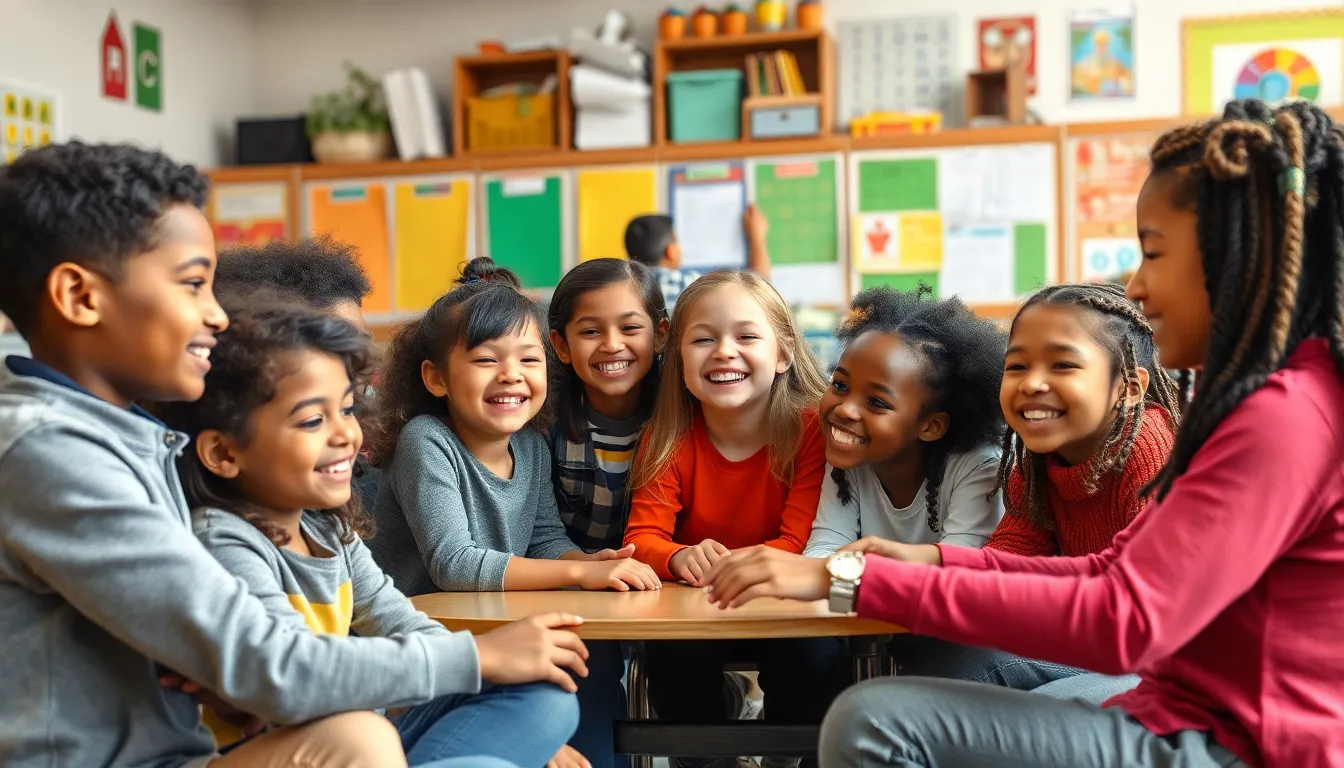Table of Contents
ToggleIn today’s fast-paced world, social-emotional learning (SEL) has emerged as a vital component of education. It equips students with essential skills to manage emotions, set goals, and build positive relationships. As academic pressures mount, fostering emotional intelligence can significantly impact a child’s overall well-being and success.
Integrating SEL into the curriculum not only enhances academic performance but also promotes a healthier school environment. By teaching children how to navigate their feelings and interact with others, educators lay the groundwork for resilient, empathetic individuals. As communities recognize the importance of SEL, it’s clear that nurturing emotional skills is just as crucial as academic achievement.
Overview of Social-Emotional Learning
Social-emotional learning (SEL) encompasses the processes that foster emotional intelligence and the skills necessary for navigating social environments. SEL includes five core competencies:
- Self-Awareness: Recognizing one’s emotions, strengths, and weaknesses.
- Self-Management: Effectively regulating emotions and behaviors, setting goals, and managing stress.
- Social Awareness: Understanding and empathizing with others’ perspectives and cultures.
- Relationship Skills: Establishing and maintaining healthy relationships through clear communication and conflict resolution.
- Responsible Decision-Making: Making choices that promote well-being for self and others.
Implementing SEL within educational settings encourages students to develop critical life skills. Students engaged in SEL programs often exhibit improved academic performance, enhanced relationships, and increased resilience. Research shows that schools incorporating SEL see higher levels of student engagement and lower rates of behavioral issues.
Educators play a pivotal role in facilitating SEL by creating supportive classroom environments. Tools and strategies include mindfulness practices, collaborative activities, and structured discussions focusing on emotional literacy. Integrating these techniques nurtures students’ social-emotional development, leading to a more positive school climate.
Ultimately, social-emotional learning serves as a foundation for students’ lifelong success, promoting both academic and personal growth.
Importance of Social-Emotional Learning

Social-emotional learning (SEL) plays a crucial role in shaping students’ academic and social landscapes. By emphasizing emotional skills alongside academic competencies, SEL contributes to holistic development.
Benefits for Students
Students benefit from SEL in several significant ways.
- Enhanced Academic Performance: Research shows that students engaged in SEL programs score higher on standardized tests due to improved focus and motivation.
- Improved Social Relationships: SEL fosters better communication and collaboration skills, helping students form healthier relationships with peers and teachers.
- Increased Resilience: Students develop coping strategies through SEL that enable them to navigate challenges effectively, enhancing their ability to persevere.
- Greater Emotional Awareness: SEL instills a deep understanding of emotions, allowing students to express feelings constructively and recognize emotions in others.
- Stronger Problem-Solving Skills: By evaluating emotions and social situations, students learn to make thoughtful decisions, benefiting both themselves and their community.
Impact on Mental Health
Social-emotional learning significantly impacts students’ mental health.
- Reduced Anxiety and Stress: SEL programs equip students with techniques like mindfulness and emotional regulation, leading to lower levels of anxiety and stress.
- Increased Self-Esteem: Students who engage with SEL display higher confidence levels, resulting in a more positive self-image and greater willingness to participate in school activities.
- Strengthened Coping Mechanisms: By learning effective coping strategies, students become better prepared to face personal and academic challenges, decreasing instances of depression.
- Promoted Positive Behavior: SEL cultivates empathy and respect, leading to more positive interactions and a reduction in behavioral issues, ultimately fostering a supportive school culture.
- Facilitated Help-Seeking Behavior: Students equipped with emotional literacy are more likely to seek help from peers and adults when struggling, promoting early intervention and support.
Key Components of Social-Emotional Learning
Social-emotional learning (SEL) consists of five key components that contribute to emotional intelligence and overall student development. Understanding these components fosters an environment conducive to personal and academic growth.
Self-Awareness
Self-awareness involves recognizing one’s emotions, strengths, shortcomings, and values. This skill allows students to identify their feelings and understand how these emotions influence their behavior. Engaging in activities like self-reflection, journaling, or discussing emotions in class cultivates this awareness. Research shows that students with strong self-awareness exhibit improved academic performance and healthier relationships with peers.
Self-Management
Self-management encompasses the ability to regulate emotions, thoughts, and behaviors in various situations. It includes setting personal goals, managing stress, and displaying self-discipline. Implementing strategies like mindfulness and goal-setting workshops helps students respond to challenges positively. Studies indicate that effective self-management directly correlates with lower levels of anxiety and enhanced academic engagement.
Social Awareness
Social awareness involves understanding and empathizing with others’ perspectives and emotions. This component emphasizes recognizing social cues and respecting diverse backgrounds. Activities like cooperative group projects and community service provide opportunities to practice social awareness. This practice enables students to foster strong connections and improve collaboration, leading to a supportive classroom environment.
Relationship Skills
Relationship skills focus on building and maintaining healthy relationships with peers and adults. Effective communication, conflict resolution, and teamwork constitute this component. Interactive lessons that promote active listening, teamwork exercises, and role-playing scenarios enhance relationship skills. Research highlights that students proficient in these skills experience enhanced social interactions and reduced conflict in school settings.
Responsible Decision-Making
Responsible decision-making involves making ethical choices, solving problems effectively, and considering the consequences of one’s actions. This component encourages critical thinking and accountability. Engaging students in discussions about real-life scenarios and dilemmas stimulates responsible decision-making. Evidence suggests that when students practice this competency, they demonstrate greater social responsibility and improved academic outcomes.
Implementation Strategies
Implementing social-emotional learning (SEL) requires a combination of targeted classroom activities and family involvement. These strategies enhance emotional and social skills essential for student development.
Classroom Activities
Classroom activities play a crucial role in SEL implementation, focusing on engaging students in practical experiences. They promote the five core competencies of SEL through various interactive methods. Examples include:
- Role-playing: Students act out scenarios that require empathy, communication, and conflict resolution.
- Mindfulness exercises: Techniques such as deep breathing and meditation help students manage stress and enhance focus.
- Group projects: Collaborative tasks foster teamwork, encouraging students to practice relationship skills and social awareness.
- Journaling: Self-reflection activities allow students to explore their emotions and thought processes, enhancing self-awareness.
- Debates and discussions: Structured conversations about ethical dilemmas enable responsible decision-making and critical thinking.
These activities create an engaging learning environment, allowing students to apply their SEL skills in real-life situations.
Family Involvement
Family involvement strengthens SEL by establishing a supportive home environment. Educators can facilitate this partnership through various approaches:
- Workshops for parents: Provide training sessions that address SEL concepts, equipping parents with strategies to reinforce these skills at home.
- Regular communication: Maintain dialogue with families through newsletters or meetings, sharing insights on students’ SEL progress and development.
- Family challenges: Encourage families to participate in activities that promote emotional skills, such as practicing gratitude or engaging in community service together.
- Resource sharing: Distribute literature and tools that inform families about SEL and its benefits for children’s emotional well-being.
Incorporating family involvement into SEL initiatives bolsters students’ social-emotional competencies and fosters a cohesive approach to personal development.
Challenges in Social-Emotional Learning
Social-emotional learning (SEL) faces several challenges that can hinder its effectiveness in educational environments. Understanding these obstacles is essential for refining implementation strategies.
Resistance to Integration
Resistance to integrating SEL into existing curricula stems from various sources. Educators may prioritize academic content over emotional development due to standardized testing pressures or lack of training. Some parents and community members might view SEL as an infringement on traditional education methods. Additionally, time constraints limit opportunities for teachers to focus on SEL alongside core subjects. Overcoming this resistance requires robust professional development, clear communication about SEL’s benefits, and the demonstration of its positive impact on academic performance and behavior.
Measurement and Assessment Issues
Measurement and assessment of SEL are complex but crucial for evaluating progress. Many schools struggle with creating reliable assessment tools that accurately reflect students’ social-emotional growth. Existing assessments often focus on cognitive skills rather than emotional competencies. Furthermore, the subjective nature of emotional development makes it challenging to quantify progress. Developing standardized assessment frameworks and utilizing multiple evaluation methods, such as student self-reflections and peer feedback, can lead to a more comprehensive understanding of SEL effectiveness.
Social-emotional learning is a vital component of modern education that shapes students into well-rounded individuals. By nurturing emotional skills alongside academic knowledge, schools can create environments where students thrive both personally and academically. The integration of SEL fosters resilience and empathy, equipping students with the tools they need to navigate life’s challenges.
As educators embrace SEL, they not only enhance student engagement but also contribute to a positive school culture. The journey towards comprehensive social-emotional education may face challenges, yet the long-term benefits for students’ mental health and interpersonal relationships are undeniable. Prioritizing SEL is an investment in the future, paving the way for a generation of emotionally intelligent and socially responsible individuals.




